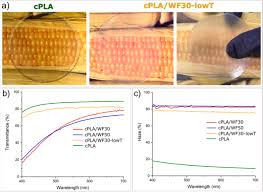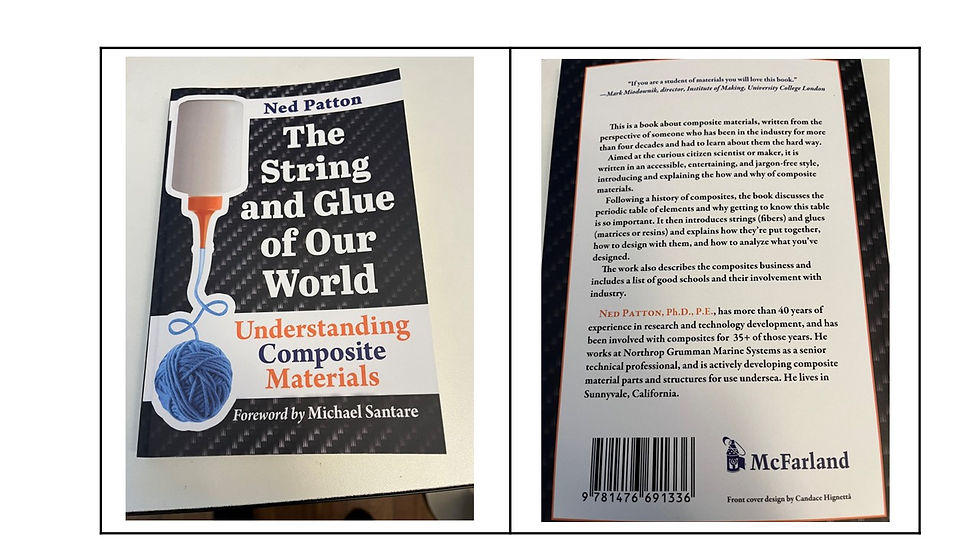Is this the Answer? Fully Bio-Based Completely Recyclable Composites
- Ned Patton

- 3 days ago
- 8 min read
A really interesting article popped up in a feed that I sort of follow but usually doesn’t have much of interest to my audience. This article was recommended to me by Research Gate, which is a non-profit based in Berlin that provides ready access for scientists and practitioners to share information and research results. It’s mostly a bunch of academics talking amongst each other, but it does have some interesting stuff from time to time. The article is about a fully bio-based and easily recyclable composite material that some researchers in Sweden have been working on for some time and have finally demonstrated at lab scale.

The title of the article I read is “Fully biobased circular biocomposites for chemical recycling to monomer and fiber” and it is available for download from “Composites Part B 306 (2025) 112814”. While there is a lot of organic chemistry in this article that I won’t present here because it really isn’t necessary, the bottom line is that these researchers started with lactide that they sourced from plant-based sugars to produce lactic acid, and then polymerized this in a non-traditional way to make a fully recyclable thermoset resin system. When this resin is decomposed to recycle it what you get back is the monomers that the resin polymerized into. So rather than having to reprocess the recovered resin into something that can be used as a resin again, what you get back is ready to make into more resin immediately.
Lactic acid is the stuff that your muscles produce in a hard workout and it is one of the simpler of the aromatic organic acids. And just to do a little myth debunking here, lactic acid is not what makes you sore after a hard workout since the lactic acid is very rapidly removed from your bloodstream. Those sore legs after a long run are from the muscle cell damage that you did and the inflammation that occurs as your body rebuilds those stressed muscles. This is the good inflammation that is the hallmark of increasing your fitness level and making it so that your next long run is a little easier than the last.
Anyway, lactide has several isomers (different shapes) which of course is common in this chemistry, one of which has an OH group making it an organic acid and the other with a COOH group (carboxylic acid group) which is the group that forms esters and acts like an acid because of that lone hydrogen attached to an oxygen atom.
These isomers of lactide are also left handed and right handed, and the OH and COOH groups can be flipped upside down as well. So this one substance we call lactide has lots of different forms, all of which act in much the same way.
The red atoms in this pic are oxygen, the black ones are carbon, and the grey ones are hydrogen. These are all isomers of lactide with L-Lactide top right, D-Lactide top left, and Meso-Lactide at the bottom. The differences in these are which side of the ring the lone hydrogens are on. If you look closely at this picture you will see that in the left and right molecule stick figures they look like just flipped images until you see the hydrogens sticking out the back of both of them. The bottom one of course makes this very clear - one out the front and one out the back. When you put a bunch of them together (L-Lactide is most commonly used to make PLA) you get polylactic acid or PLA which is a common precursor for a lot of plastics. To make a completely a plant-based or bio-based composite, they used their cleverly designed PLA to impregnate a randomly oriented mat of cellulose and hemicellulose fiber from forest products waste (wood fiber) and cured it to make their composite.
What is new here is that they demonstrated that their clever arrangement of the L-, D-, and Meso- isomers of lactide in their bio-plastic PLA allowed for a fairly standard hydrolysis type reaction to decompose the bio-PLA into lactic acid rather than water and CO2 which is the more common outcome of a hydrolysis of petroleum based PLA plastics which are made using exclusively the L-Lactide isomer. They claim that not only is it the clever arrangement of the L-, D-, and Meso- isomers, it is also the wood fiber and its ability to adsorb water to release the hydrogen bonds that are attaching the bio-PLA to the cellulose fiber surface, thereby rendering the lactides back into their original form. The claim, which is fairly well substantiated in their article because they explain all of this chemistry in detail, is that it is the clever arrangement of the lactide isomers and the reaction sites that they used to create the polymer and then bind it to the cellulose fibers that allowed them to accomplish this feat.

Sorry for all of the chemistry in this post, but I thought I needed to at least bring this to everyone’s attention because if this idea can be explored with other natural fibers like flax fiber or coconut coir, bamboo, all of the fibers that I have written about at some point. These are all cellulosic fibers and have some of the same sorts of hygroscopic properties (absorb water) as wood fiber does. If the resin chemistry can be tailored to each fiber so that what you get back when you use their hydrolysis-based resin decomposition process is pristine fiber and lactic acid when you recycle this stuff, we may have an approach that could be widespread. At least that’s the hope that this paper presents. That is, that this spurs the development of other systems based on plant resins and plant fibers that are recyclable down to pristine fiber and the monomers that were developed into the plant resins. Only time will tell.
In other news, it appears that another company in Europe – this time in the UK, has gotten some seed money to develop a pilot plant to scale up its low energy (room temperature) chemical recycling process for dissolving the resin from carbon fiber composite scrap that has not been cured yet. There is lots of this stuff that is typically just thrown away, so this is a good development that looks to have a very low carbon footprint.

Uplift360, an advanced materials technology based in Bristol, U.K. and Luxembourg, has received an Innovate UK Smart Grant to scale up its ChemR room temperature chemical recycling process for in-process scrap carbon fiber prepreg. This is similar to what Fairmat is doing with Hexcel in Salt Lake with Hexcel’s in-process prepreg scrap. This appears to be somewhat different than that used by Fairmat in that Uplift360 has developed an entirely room temperature solvent based approach where they use a proprietary solvent mixture that completely removes the resin from the fiber leaving behind pristine, ready to use carbon fiber. And they also apparently reclaim their solvent from the process so that it can be reused. And they recover the resin components since they are broken down into their original monomers through their room temperature solvolysis process. At least that is the claim here. This is a cleaner and more sustainable process for taking care of the in-process waste carbon fiber prepreg than a lot of others that are already in production. It is interesting that Uplift360 is really in the UK’s advanced Defence (UK spelling – sorry) materials business and this carbon fiber scrap recycling process they call ChemR as well as their other process for aramid fibers, RENEW, came directly out of a UK Defence funded project to recycle the aramid fiber (Kevlar) bullet-resistant vests that UK soldiers wear. It seems that most of the new and interesting research and development in composites comes from defense related projects and defense related industrial R&D. Must be that’s where the need for lighter, stronger, faster things comes from, as well as the budgets to pay for it.
That’s about it for this week, and it’s probably time to go back to less chemistry and more newsy stuff anyway for everyone’s benefit – even though the chemistry is fascinating for someone like me. As always, I hope everyone that reads these posts enjoys them as much as I enjoy writing them. I will post this first on my website – www.nedpatton.com – and then on LinkedIn. And if anyone wants to provide comments to this, I welcome them with open arms. Comments, criticisms, etc. are all quite welcome. I really do want to engage in a conversation with all of you about composites because we can learn so much from each other as long as we share our own perspectives. And that is especially true of the companies and research institutions that I mention in these posts. The more we communicate the message the better we will be able to effect the changes in the industry that are needed.
I also wanted to mention again that I will be giving a talk and chairing a session at the ICCM conference (International Conference on Composite Materials) at the Baltimore Convention Center on August 8 if anyone plans on being there. It is being hosted by my alma mater, the University of Delaware to celebrate the 50th anniversary of the founding of the Center for Composite Materials. That’s where I did my doctoral work so I know several of the people who are going to be at the conference. Should be fun.
I also have some news to share again about my second book. It has appeared in the McFarland Fall Catalog for presale - https://mcfarlandbooks.com/product/Sustainable-Composite-Materials/. As I have mentioned before, this book is a roadmap to a circular and sustainable business model for the industry which I hope that at least at some level the industry will follow. Only time will tell. And, again, our daughter has been kind enough to put together a draft of the cover of the book for my publisher to use to come up with a final version, which is included at the end of this post. Let me know whether or not you like the cover. Hopefully people will like it enough and will be interested enough in composites sustainability that they will buy it. And of course I hope that they read it and get engaged. We need all the help we can get.
Last but not least, I still need to plug my first book, so here’s the plug. The book pretty much covers the watershed in composites, starting with a brief history of composites, then introducing the Periodic Table and why Carbon is such an important and interesting element. The book was published and made available August of 2023 and is available on Amazon, Barnes and Nobles, and Google Play, along with some other less well known websites, and from McFarland Books – my publisher. However, the best place to get one is to go to my website and buy one. I will send you a signed copy for the same price you would get charged on Amazon for an unsigned one, except that I have to charge for shipping. Anyway, here’s the link to get your signed copy: https://www.nedpatton.com/product-page/the-string-and-glue-of-our-world-signed-copy. And as usual, here are pictures of the covers of both books.






Comentários